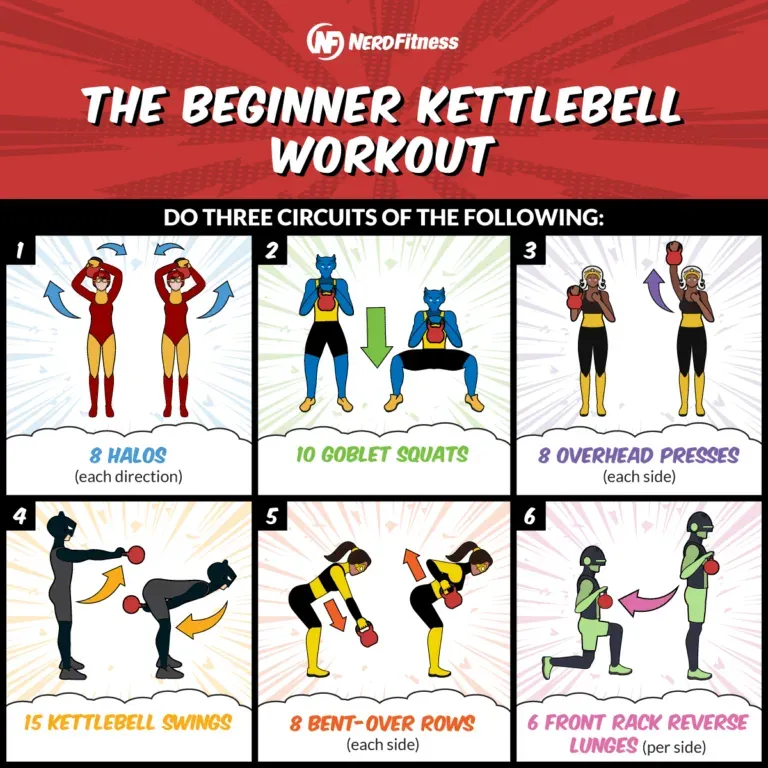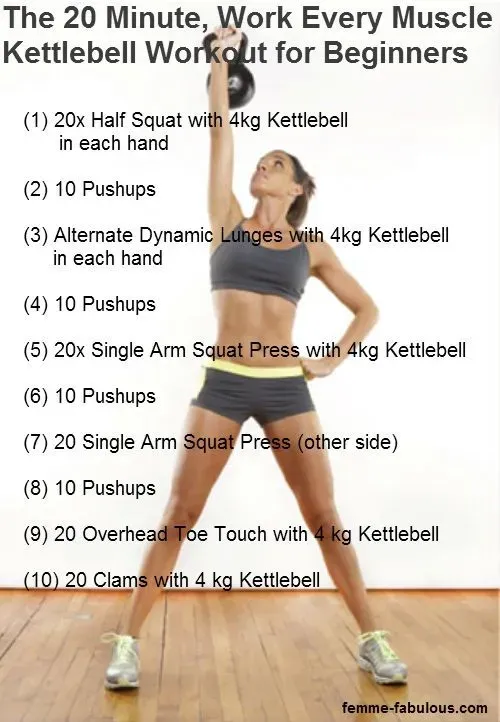Table of Contents
Tired of complicated gym machines or workout plans that require an engineering degree to understand? Maybe you just want to get stronger, burn some fat, and feel better without spending hours driving to and from a crowded fitness factory. If that sounds familiar, you're probably looking for something effective, efficient, and, well, *simple*. Good news: a simple kettlebell routine might be exactly what the doctor ordered, if your doctor recommends hoisting heavy, oddly-shaped objects for improved health.
Why a Simple Kettlebell Routine Works Wonders

Why a Simple Kettlebell Routine Works Wonders
So, you're curious about kettlebells? Excellent choice. Let's talk about Why a Simple Kettlebell Routine Works Wonders, because frankly, it’s less about chasing complicated exercise fads and more about getting serious results with minimal fuss. Think about it: you get strength training, cardio, and flexibility all rolled into one slightly awkward, cast-iron ball. Unlike barbells that require racks and plates, or dumbbells that often feel disconnected from full-body movement, the kettlebell's unique shape and off-center weight demand that your body work as a single, coordinated unit. This means you're not just building isolated muscles; you're developing real-world, functional strength that translates to everything from carrying groceries to dominating your next pickup game. Plus, these routines are notoriously efficient – you can get a killer workout in 20 minutes or less, which is perfect for those of us who don't have hours to dedicate to the gym or, let's be honest, just don't want to.
Your GoTo 20Minute Simple Kettlebell Routine

Your GoTo 20Minute Simple Kettlebell Routine
Alright, let's get down to the nitty-gritty: building Your Go-To 20-Minute Simple Kettlebell Routine. The beauty of this approach is its circuit style – you move from one exercise to the next with minimal rest, keeping your heart rate up and making efficient use of your time. This particular routine is designed to hit major muscle groups and functional movement patterns in just 20 minutes, making it perfect for those days you're short on time but still want a serious workout. We'll run through six core movements: kettlebell halos, goblet squats, overhead presses, either kettlebell swings or Romanian deadlifts (you pick based on comfort and space), bent-over rows, and front rack reverse lunges. You'll do a set of each exercise, one after the other, and then take a short breather before repeating the circuit. Simple, effective, and definitely not boring.
Mastering the Moves in Your Simple Kettlebell Routine

Mastering the Moves in Your Simple Kettlebell Routine
so you've got your cannonball with a handle, and you know the workout outline. Now comes the part where we don't just swing wildly and hope for the best. Mastering the Moves in Your Simple Kettlebell Routine is non-negotiable. It’s the difference between getting stronger and getting hurt. Don't think just because these are "beginner" moves you can slack on form. Your body doesn't care if you're a beginner; it cares if you're moving correctly under load. We're talking smooth, controlled movements here, not jerky, momentum-driven chaos. Every rep should feel intentional, from the way you grip the handle to the way you brace your core like you're about to take a punch. Focus on quality over quantity, especially when you're starting out. It might feel slow initially, but drilling proper technique now pays off big time down the road.
- Common Kettlebell Technique Slip-ups:
- Rounding your back during swings or deadlifts.
- Using only your arms for rows instead of engaging your back muscles.
- Letting your knees cave in during squats or lunges.
- Shrugging your shoulders towards your ears during overhead presses.
- Rushing through reps instead of controlling the weight.
- Gripping the handle too tightly, leading to forearm fatigue.
Picking the Right Kettlebell for Your Simple Routine

Picking the Right Kettlebell for Your Simple Routine
so you're ready to swing? Before you click "add to cart" on the first shiny ball you see, let's talk about Picking the Right Kettlebell for Your Simple Routine. This isn't rocket science, but grabbing the wrong weight or type is a surefire way to either get frustrated because it's too light or injured because it's too heavy. Think of it like picking shoes for a marathon – you wouldn't grab flip-flops, right? For beginners, the sweet spot is usually a weight you can comfortably handle for multiple reps on exercises like goblet squats or presses, but that still feels challenging for ballistic moves like swings (if you choose that variation). Men often start around 16kg (about 35 lbs), and women around 12kg (about 25 lbs), but honestly, it depends on your current strength level. Don't be afraid to go a little lighter initially to nail the form; you can always go heavier later. Also, consider the handle – some are smooth, some are coated, and a bad handle can make your hands hate you faster than you can say "calluses."
- Things to Ponder When Kettlebell Shopping:
- Weight: Can you press it overhead a few times? Can you squat with it?
- Handle Feel: Is it smooth enough not to shred your hands during swings? Is it wide enough for two hands if needed?
- Type: Standard cast iron is common, competition bells are uniform size but vary weight. For a simple routine, standard is fine.
- Ballistic vs. Grind: Do you plan on doing lots of swings (ballistic) or more controlled lifts like squats and presses (grind)? This influences the weight you need.
- Budget: They range in price, but you don't need the fanciest one to start.
Beyond the Basics: Progressing Your Simple Kettlebell Routine

Beyond the Basics: Progressing Your Simple Kettlebell Routine
Leveling Up Your Simple Kettlebell Routine: Adding Load or Volume
so you've been crushing that initial simple kettlebell routine for a few weeks now. The movements feel smooth, you're not collapsing in a heap after the circuit, and maybe that 12kg or 16kg bell feels a little less like a concrete block and more like, well, a heavy ball. This is where we talk about Beyond the Basics: Progressing Your Simple Kettlebell Routine. The most straightforward way to make things harder isn't to find a new, bizarre exercise, but to apply progressive overload to the ones you already know. You can either lift a heavier kettlebell – the classic approach – or you can do more reps or more sets with the weight you currently have. It sounds simple, almost *too* simple, but consistency with increasing weight or volume is the bedrock of getting stronger. Don't jump too fast; small, incremental increases are key. A 2kg jump in weight might not sound like much, but it's often plenty to challenge your muscles again.
Mixing It Up: Variations and Density
Once you're comfortable adding a bit more weight or cranking out extra reps, another way to progress your simple kettlebell routine is by introducing slight variations or playing with density. Instead of always doing a standard goblet squat, maybe try a pause squat at the bottom, or slow down the eccentric (lowering) phase. For presses, try pausing halfway up or at the top. You can also increase the density of your workout. This means doing the same amount of work (same exercises, reps, and weight) but in less time. Set a timer and try to complete the circuit a minute faster next time. This is a brutal but effective way to boost both strength and conditioning without needing a heavier bell right away. It forces you to be more efficient with your transitions and pushes your anaerobic capacity. Think of it as making your rest periods work for you, by shrinking them.
- Ways to Progress Your Simple Kettlebell Routine:
- Increase the kettlebell weight (the most direct method).
- Do more repetitions per set.
- Perform more sets in total.
- Reduce rest time between exercises or circuits (increase density).
- Introduce variations (e.g., pause squats, slower negatives).
- Add a timed element or work within a specific timeframe (e.g., EMOM - Every Minute On the Minute).
- Increase the frequency of your workouts (if recovering adequately).
Adding Complexity and New Movements
After you've milked the basic movements for strength and endurance gains, you can start adding slightly more complex exercises to your simple kettlebell routine. This doesn't mean abandoning the basics, but rather building on the foundation you've created. If you've been doing Romanian deadlifts, perhaps you're ready to learn the kettlebell swing – a powerful, ballistic movement that's a cornerstone of kettlebell training. Maybe you add single-leg deadlifts for balance and unilateral strength, or progress from front rack lunges to overhead lunges if your shoulder mobility is good. The key is to introduce new movements gradually and prioritize form above all else. Don't try to add swings, snatches, and cleans all at once. Pick one new challenging movement, drill it until it feels right, and then consider adding another down the line. The kettlebell world opens up considerably once you master the foundational lifts, but respect the learning curve. It's better to do a few exercises well than many exercises poorly.
Your Simple Kettlebell Journey Starts Now
Look, getting stronger and fitter doesn't require a gym membership the size of your mortgage payment or a degree in exercise science. As you've seen, a simple kettlebell routine boils down to a few fundamental movements executed with consistency. It's about quality over quantity, using that oddly-shaped weight to build real-world strength and endurance. Stop overthinking it. Grab a kettlebell, find some space, and just start. It might not always be easy, but it is simple, and that's half the battle won. Consistency is your only real secret weapon here.